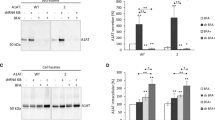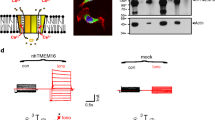Abstract
Several members of the CLCA family of proteins, originally named chloride channels, calcium-activated, have been shown to modulate chloride conductance in various cell types via an unknown mechanism. Moreover, the human (h) hCLCA1 is thought to modulate the severity of disease in asthma and cystic fibrosis (CF) patients. All CLCA proteins are post-translationally cleaved into two subunits, and recently, a conserved HEXXH zinc-binding amino acid motif has been identified, suggesting a role for CLCA proteins as metalloproteases. Here, we have characterized the cleavage and autoproteolytic activity of the murine model protein mCLCA3, which represents the murine orthologue of human hCLCA1. Using crude membrane fractions from transfected HEK293 cells, we demonstrate that mCLCA3 cleavage is zinc-dependent and exclusively inhibited by cation-chelating metalloprotease inhibitors. Cellular transport and secretion were not affected in response to a cleavage defect that was introduced by the insertion of an E157Q mutation within the HEXXH motif of mCLCA3. Interspecies conservation of these key results was further confirmed with the porcine (p) orthologue of hCLCA1 and mCLCA3, pCLCA1. Importantly, the mCLCA3E157Q mutant was cleaved after co-transfection with the wild-type mCLCA3 in HEK293 cells, suggesting that an intermolecular autoproteolytic event takes place. Edman degradation and MALDI-TOF-MS of the protein fragments identified a single cleavage site in mCLCA3 between amino acids 695 and 696. The data strongly suggest that secreted CLCA proteins have zinc-dependent autoproteolytic activity and that they may cleave additional proteins.
Similar content being viewed by others
References
Bothe, M.K., Braun, J., Mundhenk, L., and Gruber, A.D. (2008). Murine mCLCA6 is an integral apical membrane protein of nongoblet cell enterocytes and co-localizes with the cystic fibrosis transmembrane conductance regulator. J. Histochem. Cytochem. 56, 495–509.
Brouillard, F., Bensalem, N., Hinzpeter, A., Tondelier, D., Trudel, S., Gruber, A.D., Ollero, M., and Edelman, A. (2005). Blue native-SDS PAGE analysis reveals reduced expression of the mClCA3 protein in cystic fibrosis knock-out mice. Mol. Cell. Proteomics 4, 1762–1775.
Cao, J., Rehemtulla, A., Pavlaki, M., Kozarekar, P., and Chiarelli, C. (2005). Furin directly cleaves proMMP-2 in the trans-Golgi net work resulting in a nonfunctioning proteinase. J. Biol. Chem. 280, 10974–10980.
Contin, C., Pitard, V., Itai, T., Nagata, S., Moreau, J.F., and Dechanet-Merville, J. (2003). Membrane-anchored CD40 is processed by the tumor necrosis factor-alpha-converting enzyme. Implications for CD40 signaling. J. Biol. Chem. 278, 32801–32809.
Creemers, J.W., Vey, M., Schafer, W., Ayoubi, T.A., Roebroek, A.J., Klenk, H.D., Garten, W., and Van de Ven, W.J. (1995). Endoproteolytic cleavage of its propeptide is a prerequisite for efficient transport of furin out of the endoplasmic reticulum. J. Biol. Chem. 270, 2695–2702.
Cunningham, S.A., Awayda, M.S., Bubien, J.K., Ismailov, I.I., Arrate, M.P., Berdiev, B.K., Benos, D.J., and Fuller, C.M. (1995). Cloning of an epithelial chloride channel from bovine trachea. J. Biol. Chem. 270, 31016–31026.
Duszyk, M., Shu, Y., Sawicki, G., Radomski, A., Man, S.F., and Radomski, M.W. (1999). Inhibition of matrix metalloproteinase MMP-2 activates chloride current in human airway epithelial cells. Can. J. Physiol. Pharmacol. 77, 529–535.
Elble, R.C., Widom, J., Gruber, A.D., Abdel-Ghany, M., Levine, R., Goodwin, A., Cheng, H.C., and Pauli, B.U. (1997). Cloning and characterization of lung-endothelial cell adhesion molecule-1 suggest it is an endothelial chloride channel. J. Biol. Chem. 272, 27853–27861.
Gao, G., Plaas, A., Thompson, V.P., Jin, S., Zuo, F., and Sandy, J.D. (2004). ADAMTS4 (aggrecanase-1) activation on the cell surface involves C-terminal cleavage by glycosylphosphatidyl inositol-anchored membrane type 4-matrix metalloproteinase and binding of the activated proteinase to chondroitin sulfate and heparan sulfate on syndecan-1. J. Biol. Chem. 279, 10042–10051.
Gibson, A., Lewis, A.P., Affleck, K., Aitken, A.J., Meldrum, E., and Thompson, N. (2005). hCLCA1 and mCLCA3 are secreted nonintegral membrane proteins and therefore are not ion channels. J. Biol. Chem. 280, 27205–27212.
Gruber, A.D., Elble, R.C., Ji, H.L., Schreur, K.D., Fuller, C.M., and Pauli, B.U. (1998). Genomic cloning, molecular characterization, and functional analysis of human CLCA1, the first human member of the family of Ca2+-activated Cl− channel proteins. Genomics 54, 200–214.
Gruber, A.D., Elble, R.C., and Pauli, B.U. (2002). Discovery and Cloning of the CLCA Gene Family (Vol. 53).
Hamann, M., Gibson, A., Davies, N., Jowett, A., Walhin, J.P., Partington, L., Affleck, K., Trezise, D., and Main, M. (2009). Human ClCa1 modulates anionic conduction of calcium-dependent chloride currents. J. Physiol. 587, 2255–2274.
Hooper, N.M. (1994). Families of zinc metalloproteases. FEBS Lett. 354, 1–6.
Howes, J.M., Theakston, R.D., and Laing, G.D. (2007). Neutralization of the haemorrhagic activities of viperine snake venoms and venom metalloproteinases using synthetic peptide inhibitors and chelators. Toxicon 49, 734–739.
Kaup, M., Dassler, K., Weise, C., and Fuchs, H. (2002). Shedding of the transferrin receptor is mediated constitutively by an integral membrane metalloprotease sensitive to tumor necrosis factor alpha protease inhibitor-2. J. Biol. Chem. 277, 38494–38502.
Leverkoehne, I., and Gruber, A.D. (2002). The murine mCLCA3 (alias gob-5) protein is located in the mucin granule membranes of intestinal, respiratory, and uterine goblet cells. J. Histochem. Cytochem. 50, 829–838.
Mundhenk, L., Alfalah, M., Elble, R.C., Pauli, B.U., Naim, H.Y., and Gruber, A.D. (2006). Both cleavage products of the mCLCA3 protein are secreted soluble proteins. J. Biol. Chem. 281, 30072–30080.
Pauli, B.U., Abdel-Ghany, M., Cheng, H.C., Gruber, A.D., Archibald, H.A., and Elble, R.C. (2000). Molecular characteristics and functional diversity of CLCA family members. Clin. Exp. Pharmacol. Physiol. 27, 901–905.
Pawlowski, K., Lepisto, M., Meinander, N., Sivars, U., Varga, M., and Wieslander, E. (2006). Novel conserved hydrolase domain in the CLCA family of alleged calcium-activated chloride channels. Proteins 63, 424–439.
Plog, S., Mundhenk, L., Klymiuk, N., and Gruber, A.D. (2009). Genomic, tissue expression, and protein characterization of pCLCA1, a putative modulator of cystic fibrosis in the pig. J. Histochem. Cytochem. 57, 1169–1181.
Plog, S., Mundhenk, L., Bothe, M.K., Klymiuk, N., and Gruber, A.D. (2010).Tissue and cellular expression patterns of porcine CFTR: similarities to and differences from human CFTR. J. Histochem. Cytochem. 58, 785–797.
Ritzka, M., Stanke, F., Jansen, S., Gruber, A.D., Pusch, L., Woelfl, S., Veeze, H.J., Halley, D.J., and Tummler, B. (2004). The CLCA gene locus as a modulator of the gastrointestinal basic defect in cystic fibrosis. Hum. Genet. 115, 483–491.
Schlomann, U., Wildeboer, D., Webster, A., Antropova, O., Zeuschner, D., Knight, C.G., Docherty, A.J., Lambert, M., Skelton, L., Jockusch, H., et al. (2002). The metalloprotease disintegrin ADAM8. Processing by autocatalysis is required for proteolytic activity and cell adhesion. J. Biol. Chem. 277, 48210–48219.
Tortorella, M.D., Tomasselli, A.G., Mathis, K.J., Schnute, M.E., Woodard, S.S., Munie, G., Williams, J.M., Caspers, N., Wittwer, A.J., Malfait, A.M., et al. (2009). Structural and inhibition analysis reveals the mechanism of selectivity of a series of aggrecanase inhibitors. J. Biol. Chem. 284, 24185–24191.
van der Doef, H.P., Slieker, M.G., Staab, D., Alizadeh, B.Z., Seia, M., Colombo, C., van der Ent, C.K., Nickel, R., Witt, H., and Houwen, R.H. (2010). Association of the CLCA1 p.S357N variant with meconium ileus in European patients with cystic fibrosis. J. Pediatr. Gastroenterol. Nutr. 50, 347–349.
Author information
Authors and Affiliations
Corresponding author
About this article
Cite this article
Bothe, M.K., Mundhenk, L., Kaup, M. et al. The murine goblet cell protein mCLCA3 is a zinc-dependent metalloprotease with autoproteolytic activity. Mol Cells 32, 535–541 (2011). https://doi.org/10.1007/s10059-011-0158-8
Received:
Revised:
Accepted:
Published:
Issue Date:
DOI: https://doi.org/10.1007/s10059-011-0158-8




